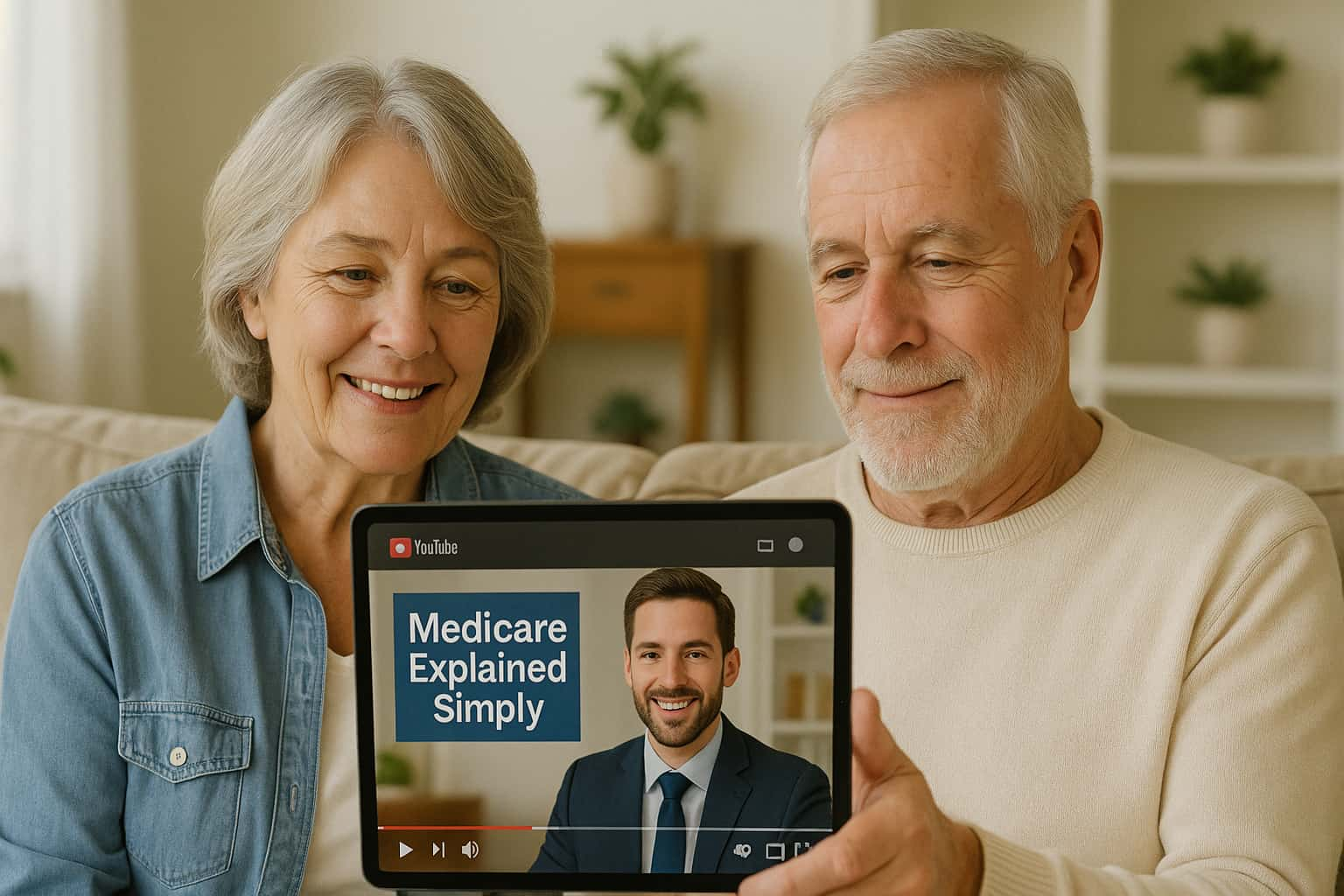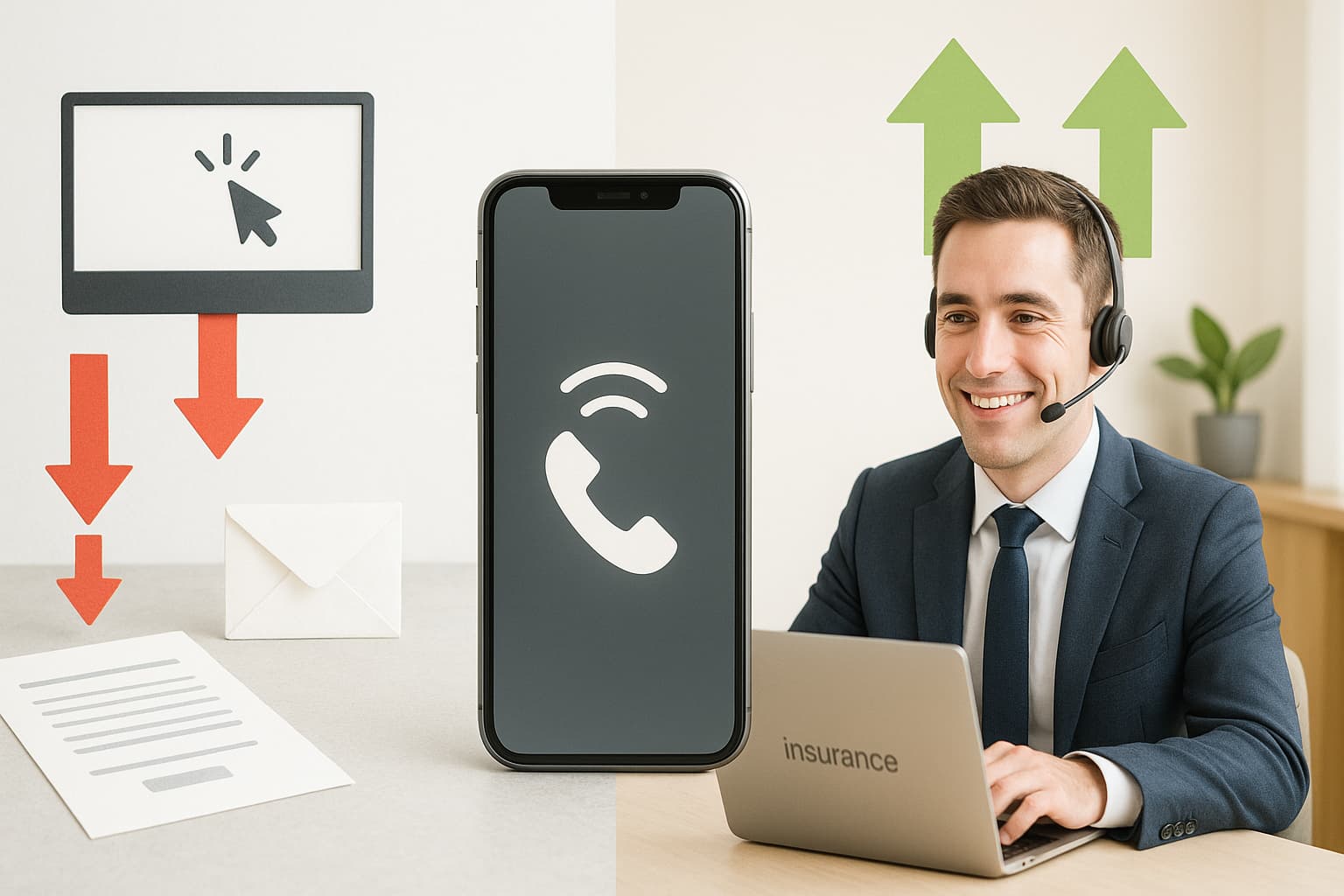How to Get Medicare Leads With Youtube
Medicare confuses millions of seniors every year. They need simple, clear answers. You can help them while growing your insurance business.
Here's the problem: 65% of Medicare-eligible people don't know which parts to choose. Only 20% understand Original Medicare basics. A huge 63% feel overwhelmed by Medicare ads.
But here's the opportunity: Seniors increasingly use YouTube to learn about health topics. They trust video content more than text. When you explain Medicare simply, you build trust and generate quality leads.
This guide shows you how to create a "Medicare Explained Simply" YouTube channel that educates seniors and grows your business. Unlike pay per lead generation companies that sell the same leads to multiple agents, this digital marketing approach generates exclusive medicare leads for your business.
Build a comprehensive marketing foundation that includes YouTube alongside a proven 4-step guide to health insurance lead generation for maximum lead generation success across all channels.
Table of Contents
Why Medicare Education Videos Work
Understanding Your Senior Audience
Creating Your Video Content
Optimizing for YouTube Discovery
Converting Viewers to Leads
Building Trust and Staying Compliant
Measuring Your Success
Why Medicare Education Videos Work for Generating Leads
Medicare is confusing by design. Multiple parts, enrollment periods, and penalty rules create a maze that intimidates seniors. This confusion creates opportunities for high quality lead generation.
Video solves this problem perfectly. Studies show people remember 95% of video content versus only 10% of text. For seniors dealing with complex information, video makes learning easier and less stressful.
Plus, video builds personal connections. When seniors see your face and hear your voice, they start trusting you before they even call. This trust is crucial in the insurance business and helps convert potential customers into clients.
The YouTube Advantage for Seniors
Don't believe the myth that seniors avoid technology. Today's 65+ generation actively uses YouTube for health information. They search for specific answers like "How does Medicare work if I'm still employed?" or "What's the difference between Medigap plans?" These marketing efforts through social media platforms can capture valuable medicare supplement leads.
Your educational videos can capture these searches and turn confused seniors into informed prospects. This approach works better than buying free insurance leads or aged life insurance leads because you're connecting with people in real time when they need help.
Understanding Your Senior Audience and Service Area
Why Seniors Find Medicare So Confusing
Three main factors create Medicare confusion:
Information overload hits seniors from all directions. Government publications, insurance marketing, and endless ads create contradictory messages. Seniors can't tell good advice from sales pitches.
System complexity makes things worse. Medicare has Parts A, B, C, and D. Each part has different rules, costs, and coverage limits. Add Medigap plans and enrollment periods, and you get a system that overwhelms most people.
High stakes increase anxiety. Miss an enrollment deadline? Pay penalties forever. Choose the wrong plan? You might lose your doctor or pay thousands more.
How Seniors Research Medicare Online
Modern seniors actively search online for Medicare help. They use specific search terms that reveal their concerns:
"Medicare Part B if still working"
"Difference between Medigap Plan F and Plan G"
"Medicare Advantage vs Original Medicare pros and cons"
"When do I need to sign up for Medicare Part D"
These searches show seniors want detailed, practical answers. Your videos should target these exact questions to improve your search results and reach more prospects in your service area.
Why Video Works Best for Medicare Education
Video outperforms other content types for several reasons:
Better retention: Visual and audio learning helps seniors remember complex rules and deadlines.
Personal connection: Seeing a real person builds trust faster than reading articles from unknown authors.
Easier processing: Age-related changes can make reading difficult. Video reduces cognitive load while delivering the same information.
Replay value: Seniors can watch videos multiple times to fully understand concepts.
Creating Your Video Content for Medicare Marketing Ideas
Core Content Topics That Generate Leads
Build your channel around these essential Medicare topics. These medicare marketing ideas work because they address real concerns seniors have:
Original Medicare (Parts A & B) Explained
Cover what Part A includes: hospital stays, skilled nursing care, some home health services, and hospice care. Most people pay no monthly premium if they worked and paid Medicare taxes.
Explain Part B coverage: doctor visits, outpatient care, preventive services, and medical equipment. Detail the monthly premium, annual deductible, and 20% coinsurance after meeting the deductible.
Use real examples: "If you have surgery, Part A covers your hospital stay. Part B covers your surgeon's fees."
Medicare Advantage (Part C) Simplified
Describe Medicare Advantage as an alternative way to get Parts A and B through private companies. These plans must cover everything Original Medicare covers, plus they often add dental, vision, and prescription coverage. This content helps you connect with prospects who might also need commercial insurance leads for other coverage needs.
Explain network restrictions clearly: "With Medicare Advantage, you usually need to stay in-network. Going outside the network costs more or isn't covered at all."
Compare HMO and PPO options using simple language seniors understand.
Prescription Drug Coverage (Part D) Made Clear
Break down Part D basics: optional coverage through private companies that Medicare approves. Explain the formulary as "your plan's list of covered drugs."
Describe the coverage gap (donut hole) simply: "You pay more for drugs after you and your plan spend a certain amount each year."
Show real examples of how drug costs change throughout the year.
Medigap Insurance Basics
Explain Medigap as insurance that helps pay costs Original Medicare doesn't cover. Emphasize that Medigap only works with Original Medicare, not Medicare Advantage.
Compare the most popular plans (G and N) using simple cost examples seniors can understand.
Enrollment Periods Without the Confusion
Create separate videos for each enrollment period:
Initial Enrollment Period: 7 months around your 65th birthday when you first become eligible.
Annual Enrollment Period: October 15 to December 7 each year when you can change Medicare Advantage or Part D plans.
Special Enrollment Periods: Times when life changes let you make Medicare changes outside normal periods.
Use calendar graphics and clear deadlines to prevent costly mistakes.
Video Structure for Maximum Clarity
Every video should follow this proven structure:
Hook (30 seconds): Start with a relatable problem. "Confused about Medicare enrollment deadlines? You're not alone."
Promise (30 seconds): Tell viewers what they'll learn. "In the next 8 minutes, I'll explain every Medicare enrollment period in simple terms."
Content delivery (5-8 minutes): Break information into small chunks. Use examples after each main point.
Summary (1 minute): Repeat the 3 most important takeaways.
Call to action (30 seconds): Invite viewers to schedule a free consultation.
Writing and Speaking for Seniors
Use simple language: Replace "comprehensive" with "complete." Say "use" instead of "utilize." Choose "help" over "facilitate."
Speak slowly and clearly: Allow time for processing. Pause between major points.
Repeat key information: Say important dates, costs, and deadlines multiple times.
Define Medicare terms immediately: "The deductible – that's what you pay before Medicare starts paying – is $226 for Part B in 2025."
Visual Design That Works for Seniors
Large, clear text: Use sans-serif fonts in high contrast colors. Black text on white backgrounds works best.
Simple graphics: Avoid cluttered charts. Use basic timelines and comparison tables.
Consistent layout: Keep the same format across all videos so viewers know what to expect.
On-screen reinforcement: Show key numbers, dates, and terms as text while you speak them.
Optimizing for YouTube Discovery and Lead Generation Services
Keyword Strategy for Medicare Content
Target "Medicare explained simply" as your main keyword phrase. This directly matches what confused seniors search for.
Add specific long-tail keywords that show buying intent:
"Medicare Part B costs 2025"
"Medicare Advantage vs Medigap comparison"
"When to enroll in Medicare if still working"
"Medicare Supplement Plan G benefits"
Research shows seniors use question-based searches. Create content around "How does," "What is," "When should," and "Which Medicare" phrases. This marketing strategy helps you compete with lead generation companies that offer free life insurance leads for agents.
Video SEO Optimization
Titles that convert: Use clear, keyword-rich titles like "Medicare Part B Costs Explained Simply | 2025 Guide" instead of generic titles.
Descriptions that sell: Start with your call-to-action in the first two lines. Include a consultation booking link immediately.
Write detailed descriptions with timestamps for YouTube Chapters. This helps seniors jump to specific topics.
Tags that target: Mix broad tags like "Medicare" and "senior healthcare" with specific tags like "Medicare Part D donut hole 2025."
Thumbnails that stand out: Use large, readable text on high-contrast backgrounds. Include a friendly face to build personal connection.
Add accessibility features: Provide accurate, synchronized closed captions for every video. Offer downloadable transcripts so seniors can read along or review content at their own pace.
Channel Organization for User Experience
Create themed playlists that guide seniors through their Medicare journey:
"Medicare Basics for Beginners"
"Understanding Medicare Parts A & B"
"Medicare Advantage Plans Explained"
"Medicare Supplement (Medigap) Guide"
"Medicare Enrollment Periods & Deadlines"
Order playlists logically. Start with basic concepts, then move to specific plan comparisons.
Feature your best educational content on your channel homepage. Create a compelling channel trailer that promises to simplify Medicare. These marketing strategies help establish your expertise and attract viewers who become quality leads.
Amplify your local visibility by combining YouTube marketing with how to get health insurance leads with local SEO to dominate both video and traditional search results in your area.
Building Community Engagement
Respond to every comment: Answer questions quickly and helpfully. This shows you care about helping seniors, not just selling insurance. These marketing efforts build trust and can work like a pay per call system where engaged viewers contact you directly.
Use the Community tab: Share Medicare deadline reminders, quick tips, and ask questions that encourage discussion.
Host live Q&A sessions: Monthly live streams let you address common questions and build personal connections with your audience.
Encourage questions: End videos by asking "What Medicare questions do you have? Ask in the comments below."
Converting Viewers to Quality Leads for Your Services Business
Crafting Calls-to-Action That Work
Your calls-to-action must feel helpful, not pushy. Seniors resist high-pressure sales tactics.
Language that builds trust:
"Have Medicare questions? Let's chat about your specific situation."
"Ready to understand your Medicare options? Schedule a free consultation."
"Confused about your choices? Book a no-pressure Medicare review."
Timing that feels natural:
Mention consultations early: "I help people with these questions every day."
Include mid-video CTAs when relevant: "This is exactly what we discuss in consultations."
End strongly: "Don't navigate Medicare alone. Click below to schedule your free consultation."
Lead Capture Through YouTube Features
End screens: Use YouTube's last 20 seconds to display clickable consultation booking links.
Cards: Add interactive cards during videos that link to relevant landing pages or consultation forms.
Pinned comments: Pin a helpful comment with your consultation link at the top of every video.
Description links: Put your main call-to-action and booking link in the first two lines of every video description.
Landing Page Optimization for Seniors
Your consultation booking page must be senior-friendly:
Simple design: Large fonts, high contrast, minimal distractions.
Clear value proposition: "Get personalized Medicare guidance from a licensed agent."
Easy form: Ask only for name, phone, email, and best time to call.
Enhance your lead qualification process by learning how to get more health insurance leads with 1 simple quiz that pre-screens prospects before they book consultations.
Trust signals: Include licensing information, testimonials, and "no-obligation" promises.
Mobile-friendly: Many seniors watch YouTube on tablets and phones.
Follow-Up That Builds Relationships
Speed matters: Contact new leads within 5-10 minutes. Interest drops quickly after that. This approach works better than waiting for free life insurance leads that multiple agents receive.
Reference the video: "Thanks for reaching out after watching my Medicare Part D video."
Lead with education: "I'd love to answer your specific Medicare questions" instead of jumping into sales.
Nurture non-ready leads: Send helpful email sequences with more educational content, deadline reminders, and exclusive resources. This approach is similar to what successful home services businesses do to stay connected with potential customers.
Building Trust and Staying Compliant
Using Social Proof Effectively
Video testimonials: Short clips of satisfied seniors explaining how your guidance helped them.
Success story examples: "After our consultation, Mary saved $200 monthly by switching to the right Medigap plan."
Community feedback: Highlight positive comments and questions from your YouTube audience.
CMS Compliance Requirements
Educational vs. marketing: Keep videos educational. Avoid promoting specific insurance companies or plans.
Required disclaimers: Include "This is for educational purposes only" and "Not affiliated with Medicare" disclaimers.
Accurate information: Update all content annually when Medicare rules change. Include "2025 information" dates in titles and descriptions.
No prohibited inducements: Don't offer gifts over $15 to encourage consultations or enrollments.
Proper use of Medicare branding: Follow CMS guidelines on using the Medicare name or logo to avoid implying government endorsement.
Ethical Lead Generation Practices
Transparency: Clearly identify yourself as a licensed insurance agent.
No-pressure approach: Emphasize that consultations are educational and no-obligation.
Privacy protection: Secure all personal information according to HIPAA and privacy laws.
Honest representation: Never imply government endorsement or make unrealistic promises.
Measuring Your Success
Key Metrics to Track
YouTube performance:
Total views and watch time
Click-through rates on thumbnails
Audience retention (where people stop watching)
Subscriber growth rate
Comments and engagement
Lead generation:
Consultation booking clicks
Landing page conversion rates
Number of scheduled consultations
Lead quality (genuine Medicare prospects)
Business impact:
Consultation-to-enrollment rate
Cost per lead from YouTube
Return on investment from video marketing
Monthly Performance Review
Content analysis: Which video topics generate the most views, engagement, and leads?
SEO performance: Which keywords drive traffic? What titles and thumbnails get clicked most?
Conversion tracking: Which calls-to-action and landing pages convert best?
Audience feedback: What questions appear repeatedly in comments? What topics do seniors request?
Continuous Improvement Strategy
Use data to refine your approach:
Double down on winners: Create more content around high-performing topics.
Fix weak points: Improve videos with high drop-off rates.
Test new approaches: Try different CTA wording, thumbnail styles, and video formats.
Stay current: Update content annually and create timely videos around enrollment periods.
Ready to Start Your Medicare YouTube Channel?
Creating a successful Medicare education channel takes time and consistent effort. But the payoff is significant: educated seniors who trust your expertise and want your help navigating their Medicare choices.
While building your YouTube presence for long-term success, supplement your lead flow immediately with how to get pay per call health insurance leads to generate qualified Medicare prospects today.
Start with one video per week covering basic Medicare topics. Focus on providing genuine value, and the leads will follow naturally.
The seniors in your community need simple, honest Medicare guidance. Your YouTube channel can be the bridge that connects their confusion to your expertise.
If you want to get pay per call insurance leads today, sign up with ResultCalls for free!

Alex Gambashidze
Marketing Associate at ResultCallsHello everyone! My name is Alex and I write these blogs to help educate small business owners on different ways to grow their business. My goal is to make lead generation as easy as possible for you. After reading these blogs, I hope you leave with some actionable steps that will get you closer to growing your business :)
2,000+
Happy local businesses
See what some of them have to say.


